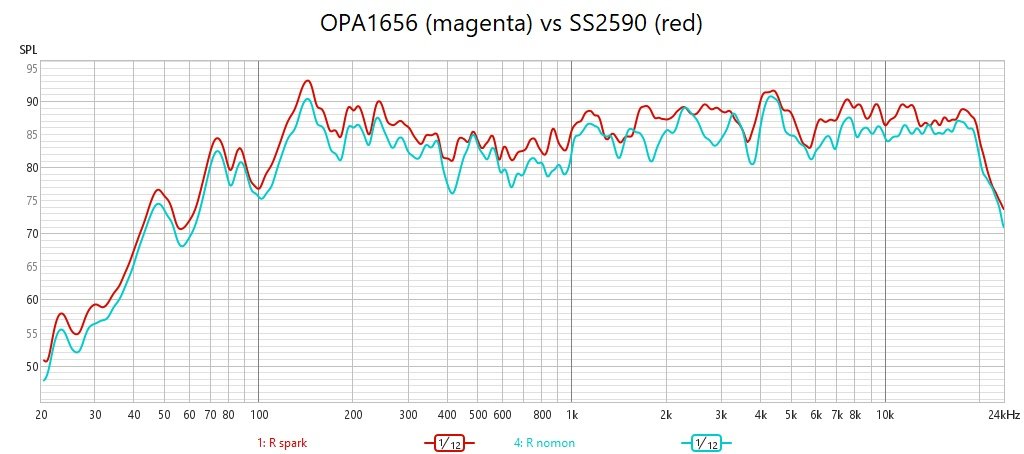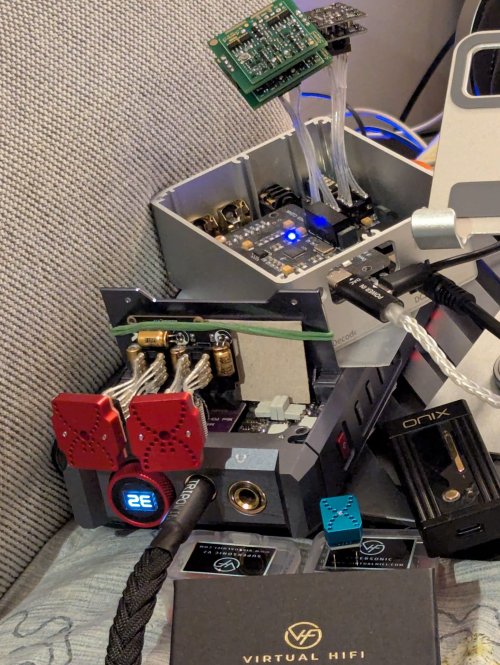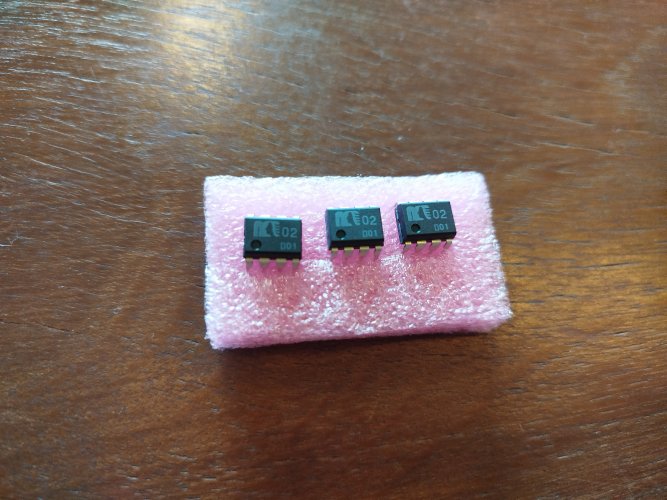Not really, it's the same situation with the PD adapters I've got and some others I've seen online.
Latest Thread Images
Featured Sponsor Listings
You are using an out of date browser. It may not display this or other websites correctly.
You should upgrade or use an alternative browser.
You should upgrade or use an alternative browser.
The Opamp thread
- Thread starter ROBSCIX
- Start date
ROBSCIX
Headphoneus Supremus
- Joined
- Aug 25, 2005
- Posts
- 6,173
- Likes
- 49
There are quite a few places that make adapters of varying quality. I suggest trying out various units from different sources until you find the units that give you what you want for a good price.
buz
500+ Head-Fier
- Joined
- Sep 13, 2009
- Posts
- 522
- Likes
- 11
Is there any source from where I can get LME49880, AD8022 and AD8066 on dual DIP8 adapters? I sure don't want to solder....
buz
500+ Head-Fier
- Joined
- Sep 13, 2009
- Posts
- 522
- Likes
- 11
Is there any source from where I can get LME49880, AD8022 and AD8066 on dual DIP8 adapters? I sure don't want to solder....
leeperry
Galvanically isolated his brain
- Joined
- Apr 23, 2004
- Posts
- 13,916
- Likes
- 2,118
Quote:
so the "shorter" side has longer traces on purpose? I find it clumsy, I'll look for other alternatives.
| Originally Posted by Mad Max /img/forum/go_quote.gif Not really, it's the same situation with the PD adapters I've got and some others I've seen online. |
so the "shorter" side has longer traces on purpose? I find it clumsy, I'll look for other alternatives.
buz
500+ Head-Fier
- Joined
- Sep 13, 2009
- Posts
- 522
- Likes
- 11
To be fair, as electrons in copper travel at at roughly 0.6-0.7c I don't think you would notice much of difference...
jezz
100+ Head-Fier
- Joined
- Jul 18, 2008
- Posts
- 192
- Likes
- 11
Quote:
It is worthwhile to try to reduce the distance between components if only because of parasitic capacitance. I've seen a few testy opamps oscillate because of it (such that they couldn't be mounted in a socket and needed to be mounted directly on a board). An exaggerated example of this is present in Gainclone amplifiers' feedback loops.
| Originally Posted by buz /img/forum/go_quote.gif To be fair, as electrons in copper travel at at roughly 0.6-0.7c I don't think you would notice much of difference... |
It is worthwhile to try to reduce the distance between components if only because of parasitic capacitance. I've seen a few testy opamps oscillate because of it (such that they couldn't be mounted in a socket and needed to be mounted directly on a board). An exaggerated example of this is present in Gainclone amplifiers' feedback loops.
joe_cool
1000+ Head-Fier
Quote:
Perhaps one way to address this is to put a bypass cap across the power supply leads on the adapter itself?
| Originally Posted by jezz /img/forum/go_quote.gif It is worthwhile to try to reduce the distance between components if only because of parasitic capacitance. I've seen a few testy opamps oscillate because of it (such that they couldn't be mounted in a socket and needed to be mounted directly on a board). An exaggerated example of this is present in Gainclone amplifiers' feedback loops. |
Perhaps one way to address this is to put a bypass cap across the power supply leads on the adapter itself?
leeperry
Galvanically isolated his brain
- Joined
- Apr 23, 2004
- Posts
- 13,916
- Likes
- 2,118
last time I tried adding 0.1uf caps on V+/V-, all it did was killing the low end bass percussion...I don't want to fix issues due to design faults. I also don't like the asymetrical pressure it'll put on the socket..
I've never been happy w/ the 2*SOIC8>1*DIP8 browndogs, but the 2*DIP>1*DIP8 have always sounded great IME anyway..
I've never been happy w/ the 2*SOIC8>1*DIP8 browndogs, but the 2*DIP>1*DIP8 have always sounded great IME anyway..
Spacehead
100+ Head-Fier
- Joined
- Jan 1, 2010
- Posts
- 423
- Likes
- 16
Quote:
Yeah I have rolled a lot of op amps now and couldn't detect much of differences. Some have better bass response, some are just more musical.
SHP2500 is not bad headphone but it just don't have that resolution that is needed to detect op amp differences. I can enjoy music a lot more when I am not troubled by too many details.

Next week I get KSC75, I wonder if those are good enough for minor details.
I have now OPA2211 on my X-FI and ADA4627-1 on PPAV2 left and right, AD8620 on ground channel and OPA1642 on DC servo.
| Originally Posted by leeperry /img/forum/go_quote.gif you're a great problem solver 
|
Yeah I have rolled a lot of op amps now and couldn't detect much of differences. Some have better bass response, some are just more musical.
SHP2500 is not bad headphone but it just don't have that resolution that is needed to detect op amp differences. I can enjoy music a lot more when I am not troubled by too many details.

Next week I get KSC75, I wonder if those are good enough for minor details.
I have now OPA2211 on my X-FI and ADA4627-1 on PPAV2 left and right, AD8620 on ground channel and OPA1642 on DC servo.
Quote:
Have you tried measuring the resistance of the adapters/sockets? I'm pretty sure that matters quite a bit based on your observations.
Doesn't appear to be an easy thing to do. The adapters I've got from diyinhk on eBay appear to have about 15k resistance. Confidence in my measurements is low, I'll just ask the seller, lol.
| Originally Posted by leeperry /img/forum/go_quote.gif last time I tried adding 0.1uf caps on V+/V-, all it did was killing the low end bass percussion...I don't want to fix issues due to design faults. I also don't like the asymetrical pressure it'll put on the socket.. I've never been happy w/ the 2*SOIC8>1*DIP8 browndogs, but the 2*DIP>1*DIP8 have always sounded great IME anyway.. |
Have you tried measuring the resistance of the adapters/sockets? I'm pretty sure that matters quite a bit based on your observations.
Doesn't appear to be an easy thing to do. The adapters I've got from diyinhk on eBay appear to have about 15k resistance. Confidence in my measurements is low, I'll just ask the seller, lol.
murrays
100+ Head-Fier
- Joined
- Jan 10, 2009
- Posts
- 302
- Likes
- 42
Quote:
What points are measuring the resistance between? The contact resistance should all be below one ohm for each individual pin. Even going from IC socket to PCB track to adapter pin should still be less than one ohm. Also, there should be no connectivity at all between different pins of the adapter (e.g. 1-2, 2-3, 2-3, etc.) which means the meter should show "infinite" or "over range".
However, if you measure them "in circuit" you will be measuring resistances of the surrounding circuit or the op-amp, rather than the adapter itself. This includes the case where the adapter is not in circuit, but has the chip inserted/attached - you will be measuring the chip.
| Originally Posted by Mad Max /img/forum/go_quote.gif Have you tried measuring the resistance of the adapters/sockets? I'm pretty sure that matters quite a bit based on your observations. Doesn't appear to be an easy thing to do. The adapters I've got from diyinhk on eBay appear to have about 15k resistance. Confidence in my measurements is low, I'll just ask the seller, lol. |
What points are measuring the resistance between? The contact resistance should all be below one ohm for each individual pin. Even going from IC socket to PCB track to adapter pin should still be less than one ohm. Also, there should be no connectivity at all between different pins of the adapter (e.g. 1-2, 2-3, 2-3, etc.) which means the meter should show "infinite" or "over range".
However, if you measure them "in circuit" you will be measuring resistances of the surrounding circuit or the op-amp, rather than the adapter itself. This includes the case where the adapter is not in circuit, but has the chip inserted/attached - you will be measuring the chip.
I measured the pins. Yes, less than one ohm from socket to trace. No, no connectivity between pins, lol, I can get that much right. xD
murrays
100+ Head-Fier
- Joined
- Jan 10, 2009
- Posts
- 302
- Likes
- 42
Where was the 15k from?
A pin, lol.
Users who are viewing this thread
Total: 31 (members: 0, guests: 31)





















